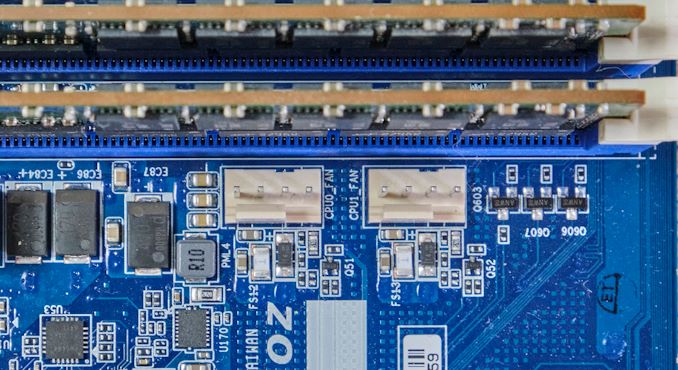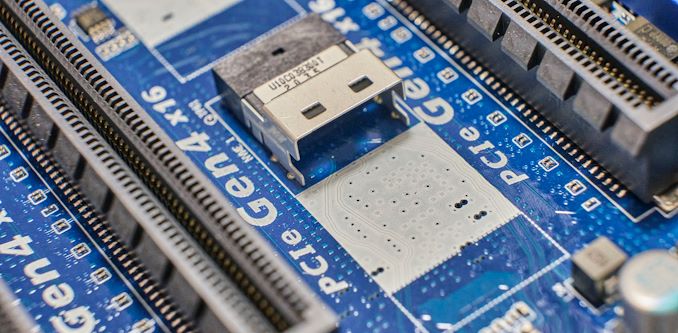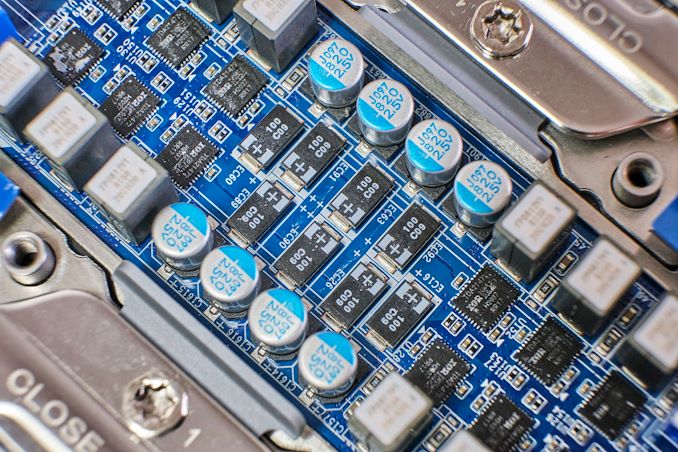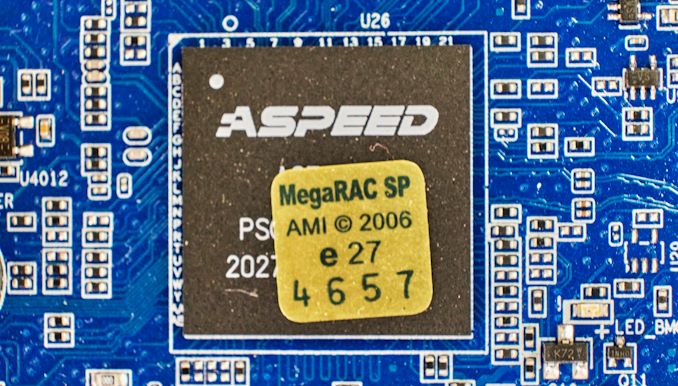The GIGABYTE MZ72-HB0 (Rev 3.0) Motherboard Review: Dual Socket 3rd Gen EPYC
by Gavin Bonshor on August 2, 2021 9:30 AM EST- Posted in
- Motherboards
- AMD
- Gigabyte
- GIGABYTE Server
- Milan
- EPYC 7003
- MZ720-HB0
Visual Inspection
From a design standpoint, the MZ72-HB0 has a typical blue GIGABYTE Server PCB, with blue memory slots, creamy white connectors, and black PCIe slots with metal slot reinforcement. Even though this is a board designed for use in a server chassis, it has an E-ATX sized frame and could be mounted into a regular chassis if a user wishes to do so. The PCB itself is littered with connectivity, including various headers, power connectors, and controllers, with practically all of the PCB playing a vital role in the board's operation. Due to the board's function over style ethos, there are no flashy RGB LEDs or such here.
Dominating the top half of the board are two SP3 sockets with support for AMD's 3rd generation EPYC Milan processors. Each SP3 socket can accommodate up to 280 W processors per socket, including the top SKU, the AMD EPYC 7763 ($7890). Due to it being a dual-socket motherboard, it doesn't support the P-series EPYC processors which are designed for single-socket motherboards only. It's also worth noting that there are two revisions of this model, the Rev 1.x which supports just EPYC 7001 (Naples) and 7002 (Rome) processors, and the one we have on test, the Rev 3.0 which supports the EPYC 7002 (Rome) and latest EPYC 7003 (Milan) processors.
Flanking each of the SP3 sockets is are eight memory slots, with sixteen memory slots in total with two EPYC processors installed. The MZ72-HB0 supports various types of memory, including RDIMM and LDRIMM up to 128 GB per module, with support for 3DS LRDIMM/RDIMM memory of up to 256 GB per module. This means users can install a maximum of 2 TB of system memory, with memory operating in eight-channel with all of the slots populated. GIGABYTE includes support for up to DDR4-3200.
Focusing on the lower portion of the board, GIGABYTE includes five full-length PCIe 4.0 slots, with the top three operating at PCIe 4.0 x16, and the bottom two operating at PCIe 4.0 x8. Given that this is a dual-socket motherboard, each of the CPUs control different slots in the following configuration:
- Slot_6 - PCIe 4.0 x16 (CPU 0) - Top slot
- Slot_4 - PCIe 4.0 x16 (CPU 0)
- Slot_3 - PCIe 4.0 x16 (CPU 1)
- Slot_2 - PCIe 4.0 x8 (CPU 0)
- Slot_1 - PCIe 4.0 x8 (CPI 1) - Bottom slot
For cooling, GIGABYTE includes a total of six 4-pin headers, with two for CPU fans, and four for chassis fans. The two CPU fans are located by the right-hand CPU socket, whereas the rest can be found along the bottom of the PCB.
Sandwiched in-between the top two full-length PCIe slots (Slot_6/Slot_4), are two PCIe 4.0 x4 SlimSAS headers, This allows for more NVMe based storage options to be used, which is commonplace in the data center.
Other storage options on the GIGABYTE MZ72-HB0 include three SlimSAS ports, with each port allowing for four SATA ports (twelve in total), or users can use each slot for additional NVMe capable PCIe 4.0 x4 storage. For users looking to install single drives, GIGABYTE includes four 7-pin SATA slots.
The power delivery on the MZ72-HB0 is quite intricate and complicated, which is often the case on monstrous dual-socket motherboards. Starting with the CPU VCore, each socket has its own independent power delivery with six Infineon TDA21472 power stages and is driven by an International Rectifier IR35201 PWM controller. This means that each SP3 socket has a 6+0 phase power delivery.
Looking at the memory section of the power delivery, GIGABYTE is using six Infineon TDA21462 60 A power stages in two groups of three for each set of eight memory slots. It is controlled using an International Rectifier IR3584 PWM controller, with two sets of these operating independently. For the VSoC section, GIGABYTE is using two Infineon TDA21462 60 A power stages and is controlled by a single International Rectifier IR35204 PWM controller. Again, there are two sets of these with one for each installed processor.
Keeping the CPU section of the power delivery cool is an aluminum heatsink with a long strip which is held into place with two black plastic clasps with springs. The main bulk of the cooling properties which sit directly over the power stages is a large finned section, which is designed to use airflow to dissipate the heat effectively - anyone using this board has to make sure there is lots of airflow, as if the board is in a server in a datacenter. The memory and VSoC areas of the power delivery don't include heatsinks, and instead, rely heavily on the airflow.
GIGABYTE's baseboard management controller (BMC) of choice is the ASPEED AST2600. This allows board management functionality including both over JAVA and HTML5 formats, as well as LDAP/AD/RADIUS support, and access to GIGABYTE's AMI MegaRAC SP-X browser-based interface.
On the rear panel is a basic, yet functional set of input and output. In terms of USB, there are just two USB 3.0 Type-A ports, with front panel headers offering for more expansion; one USB 3.1 G1 Type-A header offering two Type-A ports, and one USB 2.0 header, also offering two additional Type-A ports. Networking is premium, with one Realtek RTS5411E Gigabit management port offering access to the BMC, with two 10 GbE BASE-T ports powered by a Broadcom BCM57416 Ethernet controller. Also on the rear panel is a D-Sub, which allows users to connect to the board's ASPEED BMC controller, a serial COM port, and an ID button with a built-in LED.



















28 Comments
View All Comments
watersb - Tuesday, August 3, 2021 - link
Awesome, I always learn something here!The 20A receptacles aren't all that unusual, a good commercial-grade 20A is in regular stock at my local hardware store... and I live in a remote small town.
Mikewind Dale's suggestion is sound: run a 20A if you're putting anything new in. Just be certain you don't string that behind an older 15A breaker! Should be a home run from your receptacle direct to the panel. Don't know if isolated ground specifically makes a difference, but it would likewise be a trivial cost.
Does anyone make a 20A ATX power supply? They are more common in the data center, and one of my home rack PDUs showed up in the 20A version. (Then I got a Raspberry Pi, and replaced two servers with my MacBook Pro M1, and the power delivery system looked a bit embarrassed. So of course it's time to buy more silly gear...)
Foeketijn - Wednesday, August 4, 2021 - link
I never understood why the US never changed the voltage system. The reason the US still uses 110V dual phase, is because after supporting World wide triple phase 220V the government found out it saved loads of copper. And the copper industry was depending on using that much copper.But nowadays the Chinese make the copper anyways.
3600W from a normal fuse. 11kW from a normal triplephase 3 fuse outlet is your house has triple phase.
Being wary about fuses just is not a European/Asian thing. Nor should it be American
mnemotronic - Tuesday, August 3, 2021 - link
Server board? Please tell me it supports ECC memory.Mikewind Dale - Wednesday, August 4, 2021 - link
It supports RDIMM and LRDIMM. Although that's not the same as ECC, it's pretty much 100% correlated with ECC. I've never heard of a server board that supports RDIMM and LRDIMM but not ECC.Heck, most ThreadRipper non-Pro boards support ECC, and many Ryzen boards do. It would be unthinkable for this board not to support ECC.
Mikewind Dale - Wednesday, August 4, 2021 - link
And just for comparison, Gigabyte's ThreadRipper Pro WRX80-SU8-IPMI board says "Support for UDIMM (ECC), RDIMM, 3DS RDIMM and LRDIMM memory modules". Notice that "ECC" is a qualifier for "UDIMM". It appears that for Gigabyte, ECC is only a question for UDIMM; for RDIMM and LRDIMM, ECC goes without saying.bananaforscale - Friday, August 6, 2021 - link
"Size E-ATX"There's "larger than ATX" but there's no E-ATX standard.
Axel_K. - Tuesday, August 10, 2021 - link
When will this motherboard be available at online retailers? By googling I find that it is widely available only in Russia. When will it be available in the US and other countries?MirrorMax - Saturday, August 28, 2021 - link
Few errors in the article. Epyc rome already had 280w cpus with the 7H12, which was supported on the rev1 board. and there's nothing new on the rev3 board except a rome/milan bios instead of the naples/rome bios from what I can see. I assume they couldn't fit all 3 gens into one bios. Rev1 boards are also flashable to milan/rome bios according to gigabyte support. they are not too happy about customers bios flashing unless they have issues so i assume thats why they released this a seperate Rev not just a bios update.